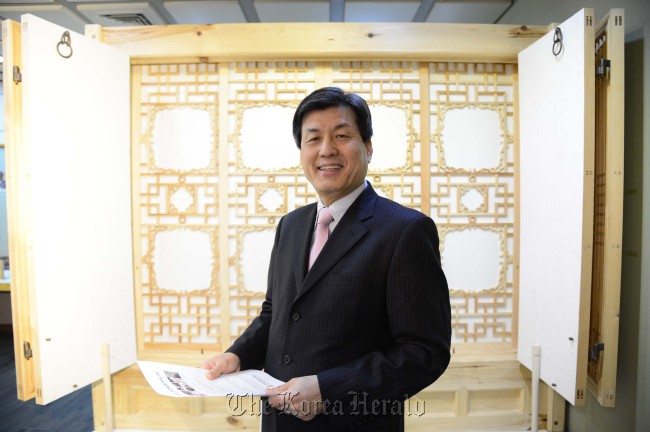Heritage foundation promotes ‘K-Heritage’
Korea Cultural Heritage Foundation seeks to brand cultural heritage at home and abroad
By Korea HeraldPublished : Jan. 16, 2013 - 19:20
Korea is now reaching out beyond its borders to help other countries restore their cultural and historical heritage and promote Korean heritage to the world.
The Korea Cultural Heritage Foundation on Tuesday said that it would launch a restoration project of Vat Phou Temple in the Champasak area of southern Laos in February. The temple, believed to have been built in the 10th century, is considered the starting point of the road to the ancient Khmer monastery of Angkor Wat, a UNESCO World Heritage site.
“It will be a new wave of overseas development assistance. So far, the government has been focusing on building IT and other infrastructure in developing countries. But we will go back to the origin of the culture of the respective country and help them restore it,” said Lee Se-seop, president of the Korea Cultural Heritage Foundation, in an interview with The Korea Herald on Tuesday.
Korean restoration crews will be working with those from Italy and France who have already started working on restoring some parts of the temple.
“Stone-structure experts, historians and others will be dispatched to the Southeast Asian country to survey the site in detail, study the foundation, and plan the extent of the restoration for the six-year project,” Lee said.
The Korea Cultural Heritage Foundation on Tuesday said that it would launch a restoration project of Vat Phou Temple in the Champasak area of southern Laos in February. The temple, believed to have been built in the 10th century, is considered the starting point of the road to the ancient Khmer monastery of Angkor Wat, a UNESCO World Heritage site.
“It will be a new wave of overseas development assistance. So far, the government has been focusing on building IT and other infrastructure in developing countries. But we will go back to the origin of the culture of the respective country and help them restore it,” said Lee Se-seop, president of the Korea Cultural Heritage Foundation, in an interview with The Korea Herald on Tuesday.
Korean restoration crews will be working with those from Italy and France who have already started working on restoring some parts of the temple.
“Stone-structure experts, historians and others will be dispatched to the Southeast Asian country to survey the site in detail, study the foundation, and plan the extent of the restoration for the six-year project,” Lee said.

The foundation is also planning to hold similar projects in the old Cambodian temple of Preah Pithu and possibly in the ancient Myanmar city of Bagan in association with the Korea International Cooperation Agency.
“Korea has a wealth of stone-made heritage from the old days and we have an abundant pool of manpower and techniques to support the restoration,” said Kim Kwang-hee, a team manager at the foundation.
The restoration aid plans are part of the K-Heritage project that the foundation launched two years ago when Lee took the helm of the organization, which is partly subsidized by the government to preserve and transmit traditional culture.
An innovative revenue-generating project, the CHF has been developing handicrafts and souvenirs under the K-Heritage brand which are sold at Incheon International Airport’s duty-free shopping zones and the National Palace Museum shop. The foundation also hosts concerts and exhibitions of state-designated artisans, and supports their livelihood.
“We are still at the beginning stage of branding Korean cultural heritage. We have a long way to go,” Lee said.
It is true that the majority of Koreans have been rather indifferent to the traditions and cultural heritage of the country despite understanding their value. Thanks to the inclusion of Arirang and 14 other pieces of intangible heritage on the UNESCO Intangible Cultural Heritage of Humanity List, a growing number of people are becoming aware of the need for the preservation of culture.
In 2010, the Korea Cultural Heritage Foundation was designated as a UNESCO-accredited NGO by UNESCO’s Intergovernmental Committee for the Safeguarding of Intangible Cultural Heritage, advising UNESCO on the protection of international intangible cultural heritage. The foundation is also engaged in various activities related to the management of the Urgent Safeguarding List.
This year, Korea is gearing up to have “gimjang,” the annual kimchi-making session for wintertime, added to the UNESCO list. Since kimchi has become more of a global delicacy in recent years, the government has decided to push the making of kimchi as a uniquely Korean custom. The CHF will participate in the application process.
“Every year, neighbors, relatives and friends would gather and make kimchi, share laughter and ‘jeong’ (Korean sentiment of affection and friendship). This is going to be a great value to keep,” Lee said. “We are hoping to contribute more to including our cultural assets on the UNESCO list in the future,” he added.
“The inscription itself does not guarantee economic or other benefits. But it brings us together and reminds us of the rich culture that we can be proud of,” Lee said.
By Bae Ji-sook (baejisook@heraldcorp.com)
-
Articles by Korea Herald








![[Today’s K-pop] BTS pop-up event to come to Seoul](http://res.heraldm.com/phpwas/restmb_idxmake.php?idx=644&simg=/content/image/2024/04/17/20240417050734_0.jpg&u=)

![[Graphic News] More Koreans say they plan long-distance trips this year](http://res.heraldm.com/phpwas/restmb_idxmake.php?idx=644&simg=/content/image/2024/04/17/20240417050828_0.gif&u=)






![[KH Explains] Hyundai's full hybrid edge to pay off amid slow transition to pure EVs](http://res.heraldm.com/phpwas/restmb_idxmake.php?idx=652&simg=/content/image/2024/04/18/20240418050645_0.jpg&u=20240419100350)

